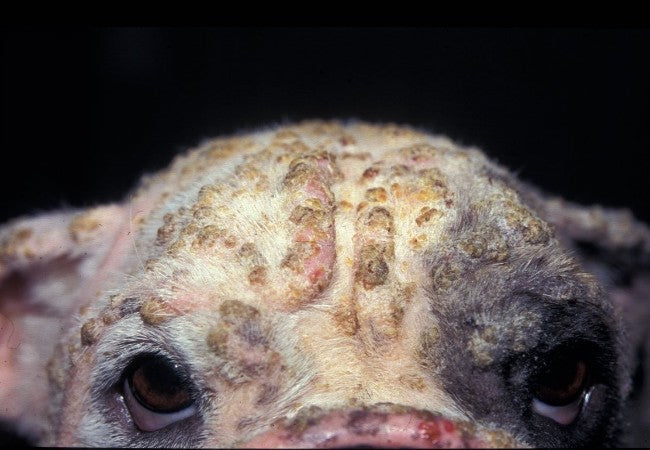Vet’s 2025 Guide to Canine Pemphigus Foliaceus Autoimmune Skin Care & Therapy 🩺

In this article
Vet’s 2025 Guide to Canine Pemphigus Foliaceus Autoimmune Skin Care & Therapy 🩺
By Dr. Duncan Houston BVSc
💡 Introduction
Pemphigus foliaceus (PF) is the most common autoimmune skin disease in dogs, characterized by immune-mediated attacks on skin adhesion molecules, leading to pustules, crusts, erosions, and hair loss. While diagnosis and treatment are complex, most dogs respond well to immunosuppressive therapy managed over months to years.
1. What Is Pemphigus Foliaceus?
PF occurs when autoantibodies (mainly IgG) target keratinocyte desmoglein-1, disrupting cell adhesion near the skin’s surface, leading to acantholysis (skin cell separation).
Common lesions include superficial pustules, erosions, crusts, and scaling—often affecting the face, ears, paw pads, and groin.
2. Who’s at Risk?
- Age: Mostly adults over 4–7 years, though younger dogs may be affected.
- Breeds predisposed: Akita, Chow Chow, Doberman, Newfoundland, Collie, Cocker Spaniel, Dachshund, Shar-Pei, Schipperke, English Bulldog, and more.
- Possible triggers: Sun exposure, certain medications (e.g., Sulfa, penicillins, ectoparasite agents), or other skin diseases.
3. Recognizing the Signs
Signs include:
- Pustules and erosions on nose, ears, paw pads, groin
- Crusting and scaling, often symmetrical
- Alopecia, pruritus, pain
- Secondary bacterial infections commonly worsen symptoms.
4. How PF Is Diagnosed 🧪
4.1 Cytology
A superficial skin scrape or pustule aspirate may show acantholytic keratinocytes and inflammatory cells—highly suggestive but not definitive.
4.2 Skin Biopsy & Histopathology
Punch biopsies of active lesions are essential—pathology confirms subcorneal pustules with acantholytic cells.
4.3 Other Tests
- Culture to rule out bacterial or dermatophyte infections
- Assess potential systemic triggers or comorbidities
5. 2025 Treatment Strategies ❤️
5.1 Induction of Remission
“Hit hard, then taper” strategy:
- Corticosteroids: Prednisone/methylprednisone at 1–2 mg/kg daily, or high-dose pulse therapy (10 mg/kg for 3 days) in severe cases.
- Cyclosporine: 5–10 mg/kg daily; often combined, showing steroid‑sparing effects.
- Azathioprine: 1–2 mg/kg daily as adjunct to reduce steroid side effects.
- Mycophenolate or chlorambucil: Alternative immunosuppressants when needed.
- Oclacitinib: May relieve pruritus and is comparable to azathioprine in combination therapy.
5.2 Maintenance Therapy
Taper steroids by ~25% every few weeks; maintain lowest effective dose with one or two immunosuppressants.
5.3 Topical & Adjunctive Care
- Topical corticosteroids or tacrolimus
- Medicated baths (e.g., chlorhexidine) to reduce infection
- Antimicrobial therapy for secondary infections
- Sun avoidance—UV can worsen the disease.
6. Prognosis & Long‑Term Outlook
- Dogs: ~50% complete remission, ~35% partial; ~13% euthanised due to refractory disease or side effects.
- Cats: Higher remission (~90%).
- Relapses common; many require lifelong immunosuppressive care.
7. Home Care & Ask A Vet Integration 🏡
- Track lesions, pruritus, and medication side effects via app
- Reminders for medications, follow-up exams, and lab monitoring (CBC/liver function)
- Provide photo uploads for remote progress checks
- Alerts for emergencies: new lesions, infection signs, gastrointestinal effects
8. Coping with Side Effects & Monitoring
- Monitor side effects: PU/PD, weight gain, GI upset
- Safe transition to steroid-sparing therapy reduces risks
- Proactive bloodwork schedule to monitor for immunosuppressant toxicity
9. When to See Your Veterinarian
- No improvement after 4–6 weeks
- Signs of infection, systemic illness
- Severe side effects (e.g., vomiting, lethargy, PU/PD)
- New flare-ups during tapering
🔍 Summary Takeaways
- PF is a serious but treatable autoimmune skin disease in dogs.
- Diagnosis requires skin biopsy and ruling out infection.
- Combination immunosuppression achieves remission more often.
- Maintenance requires tracking, periodic bloodwork, and side effect management.
- Ask A Vet supports home care, reminders, and professional guidance.
🩺 Conclusion ❤️
Canine pemphigus foliaceus demands skilled veterinary care, patience, and consistent management. In 2025, multimodal therapy (steroids plus steroid-sparing drugs) helps most dogs achieve remission. With Ask A Vet aiding compliance, monitoring, and communication, your dog can enjoy comfort, health, and fewer flare-ups. 🐶✨
Dr Duncan Houston BVSc – dedicated to skin‑wise, compassionate veterinary care.
Find more help at AskAVet.com and download the Ask A Vet app for personalized tracking, vet access, and guidance throughout treatment. ❤️






